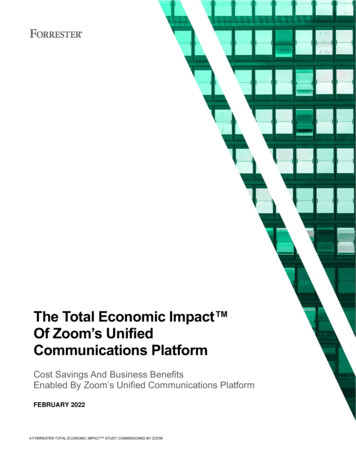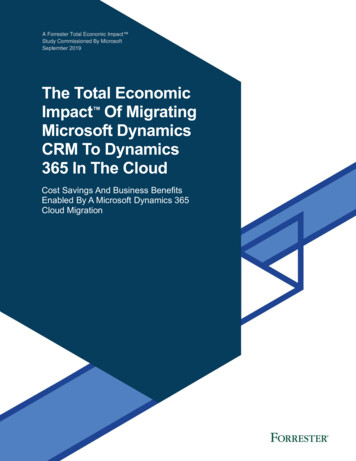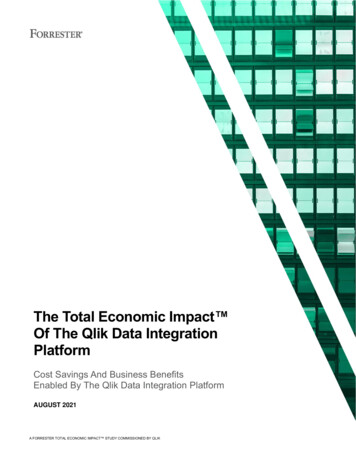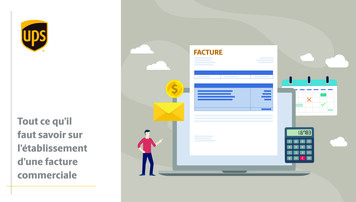
Transcription
The Total Economic Impact Of Zoom’s UnifiedCommunications PlatformCost Savings And Business BenefitsEnabled By Zoom’s Unified Communications PlatformFEBRUARY 2022A FORRESTER TOTAL ECONOMIC IMPACT STUDY COMMISSIONED BY ZOOM
Table Of ContentsConsulting Team: Nick MayberryExecutive Summary . 1The Zoom Customer Journey . 6Key Challenges . 6Solution Requirements . 7Composite Organization . 7Analysis Of Benefits . 9Improved Meeting Productivity . 9Improved Time-To-Value Of Sales . 12Improved Efficiency Of Help Desk OperationsAnd Productivity Of Employees . 13Reduced Expenses Of Redundant SolutionsAnd Travel . 15Unquantified Benefits . 17Flexibility . 19Analysis Of Costs . 21Total Zoom Fees . 21Costs Of Implementation And Deployment . 22Costs Of Training And Ongoing Management . 23Financial Summary . 25Appendix A: Total Economic Impact . 26Appendix B: Endnotes . 27ABOUT FORRESTER CONSULTINGForrester Consulting provides independent and objective research-based consulting to help leaders succeed in theirorganizations. For more information, visit forrester.com/consulting. Forrester Research, Inc. All rights reserved. Unauthorized reproduction is strictly prohibited. Information is based onthe best available resources. Opinions reflect judgment at the time and are subject to change. Forrester , Technographics ,Forrester Wave, RoleView, TechRadar, and Total Economic Impact are trademarks of Forrester Research, Inc. All othertrademarks are the property of their respective companies.THE TOTAL ECONOMIC IMPACT OF ZOOM’S UNIFIED COMMUNICATIONS PLATFORM
Executive SummaryZoom for unified communications enabled organizations to add up to 52 weekly minutesworth of productivity per employee, reduce the time-to-value of sales by 70%, reduce ITtroubleshooting time by 75%, and decommission a number of redundant technologiesvalued at up to tens of millions of dollars annually. It also improved organizationalresilience during the COVID-19 pandemic, improved employee and customersatisfaction, and boosted employee collaboration.Zoom offers a cloud-based unified communicationsplatform featuring videoconferencing via ZoomKEY STATISTICSMeetings, telephony solutions via Zoom Phone,conference room video solutions via Zoom Rooms,and messaging via Zoom Chat. Zoom commissionedForrester Consulting to conduct a Total EconomicImpact (TEI) study and examine the potentialreturn on investment (ROI) enterprises may realizeReturn on investment (ROI)Net present value (NPV)by deploying Zoom’s unified communications261% 33.42Mplatform.1 The purpose of this study is to providereaders with a framework to evaluate the potentialfinancial impact of Zoom’s unified communicationsPrior to using Zoom, these decision-makers notedplatform on their organizations.how their organizations spent heavily on multipleTo better understand the benefits, costs, and risksvideo and telephony solutions that were difficult toassociated with this investment, Forrester interviewedaccess or use for their employee end users.decision-makers with experience using Zoom fromAdditionally, legacy solutions had unreliable callfour organizations ranging from 5,000 employees toquality, impacting both customer relationships and255,000 employees. For the purposes of this study,employee satisfaction. The poor software quality andForrester aggregated the decision-makers’security risks of these tools also created more workexperiences and combined the results into a singlefor the decision-makers’ IT departments.composite organization.After deploying Zoom for unified communications, thedecision-makers’ organizations quickly boostedemployee productivity, as Zoom was easy to deployTotal benefits:and use. Videoconferencing and call qualityimproved, benefiting customer relationships and 46.23 millionemployee satisfaction. Sales professionals neededfewer interactions with customers to make a sale,while the IT department became more efficient, usingZoom for virtual help desk operations. Lastly,decision-makers’ firms saved up to tens of millions ofdollars annually from decommissioning legacy videoTHE TOTAL ECONOMIC IMPACT OF ZOOM’S UNIFIED COMMUNICATIONS PLATFORM1
EXECUTIVE SUMMARYand telephony solutions, while reducing costs relatedallowed employees with technology issues toto employee-expensed personal Zoom accounts andreach out to IT sooner and get their issueemployee travel.resolved 75% faster than they had prior to usingZoom. This not only saved time costs for IT butKEY FINDINGSalso boosted the productivity of employees, whoQuantified benefits. Risk-adjusted present valuecould return to work faster. These savings were(PV) quantified benefits include:based only on Zoom’s current offering and not on the upcoming Zoom Contact Center solution.Boosted employee productivity by up to 52minutes per employee per week. Zoom’s ease Reduced redundant solution and travelof use, even for novices, helped employeesexpenses by nearly 4 million annually. Zoomadopt and begin using Zoom at a faster rate thanalso enabled the decision-makers’ organizationsprior solutions. This meant employees recoupedto save costs on several ongoing expenses,productivity for meetings that were often skippedincluding:due to the difficulty of setting up prior solutions. Additionally, Zoom Rooms removed the delaysDecommissioning multiple solutions forcaused by prior conference room video solutions’videoconferencing and telephony, savingtechnical issues, making meetings moremillions of dollars annually.productive. Replacing preexisting, companyexpensed personal Zoom accounts,saving tens of thousands of dollarsannually and improving compliance by“After deployment, Zoom washeralded big-time internally, fromthe CEO on down. To be honest,it probably saved the CIO’s job.”VP of IT, IT servicesreducing shadow IT. Reducing travel expenses as much as 1.9 million annually for one decisionmakers’ firm.Unquantified benefits. Additional benefits thatcustomers experienced but were not able to quantifyinclude: Improved time-to-value of sales by 70%. ZoomFast adoption. Zoom was easier and quicker forenabled sales professionals to be more efficientemployees to get up and running. This led towith their customer calls, and the personalizedwider and faster adoption of Zoom whennature of videoconferencing helped them closecompared with prior solutions. The executivedeals 70% faster than in their prior environment.director from a financial services firm shared thatSalespeople could then use recouped time forafter two months, they had 250,000 meetings andadditional sales efforts, improving the profitability25 million minutes on Zoom daily.of their organizations. Improved customer satisfaction and support.Reduced time for help desk to troubleshootZoom enabled organizations to improve theiremployee technology issues by 75%. Zoomcustomer satisfaction and customer supportalso enabled organizations to set up aoperations by providing video-first interactionsvideoconference-based virtual help desk. ThisTHE TOTAL ECONOMIC IMPACT OF ZOOM’S UNIFIED COMMUNICATIONS PLATFORM2
EXECUTIVE SUMMARY and better visibility into call center data forThe decision-maker interviews and financial analysisindividual business units.found that a composite organization experiencesImproved organizational resilience. WithZoom, organizations maintained operations and aconsistent level of employee and IT productivity,benefits of 46.23 million over three years versuscosts of 12.81 million, adding up to a net presentvalue (NPV) of 33.42 million and an ROI of 261%.even as these organizations shifted operations toremote or hybrid setups during the COVID-19pandemic. Improved security and compliance. Investingin a corporate-level Zoom deployment alsohelped the decision-makers’ firms reduce theprevalence of shadow IT, ensuring compliancewith company and regulatory requirements. Zoom support. Zoom’s support professionalsnot only helped organizations with their changemanagement practices after implementing Zoombut also helped one customer integrate theirpreferred solutions into Zoom.Costs. Risk-adjusted PV costs include: Licensing costs. Zoom solutions are charged ona per-user monthly basis. For the composite, with18,000 Zoom Meetings and Zoom Chat usersand 10,000 Zoom Phone users, licensingamounts to less than 2.7 million annually. ZoomRooms is priced at an additional 45 per roomper month. Implementation and deployment costs.Implementation and deployment for ZoomMeetings and Zoom Phone took approximatelyone month for four FTEs. Zoom Rooms hadadditional internal time costs for its deployment. Costs of training and ongoing management.Customers reported needing one hour to trainemployees on the new Zoom deployments. Theyalso assigned several employees to manageZoom on an ongoing basis. Ongoingmanagement costs depended heavily on thenumber and type of Zoom solutions deployed.THE TOTAL ECONOMIC IMPACT OF ZOOM’S UNIFIED COMMUNICATIONS PLATFORM3
EXECUTIVE SUMMARYROIBENEFITS PVNPVPAYBACK261% 46.23M 33.42M 6 monthsBenefits (Three-Year)Improved meeting productivity 14.8MImproved efficiency andtime-to-value of sales 13.1MReduced expenses ofprior solutions and travel 9.4MImproved efficiency ofhelp desk operationsand productivity of employees 9.1MFinancial SummaryPayback period: 6 monthsTotal benefits PV, 46.2MTotal costs PV, 12.8MInitialYear 1Year 2THE TOTAL ECONOMIC IMPACT OF ZOOM’S UNIFIED COMMUNICATIONS PLATFORMYear 34
EXECUTIVE SUMMARYTEI FRAMEWORK AND METHODOLOGYFrom the information provided in the interviews,Forrester constructed a Total Economic Impact framework for those organizations considering aninvestment in Zoom’s unified communicationsDUE DILIGENCEInterviewed Zoom stakeholders and Forresteranalysts to gather data relative to Zoom’s unifiedcommunications platform.platform.The objective of the framework is to identify the cost,benefit, flexibility, and risk factors that affect theinvestment decision. Forrester took a multistepDECISION-MAKER INTERVIEWSInterviewed one decision-maker each at fourorganizations using Zoom’s unifiedapproach to evaluate the impact that Zoom’s unifiedcommunications platform to obtain data withcommunications platform can have on anrespect to costs, benefits, and risks.organization.COMPOSITE ORGANIZATIONDesigned a composite organization based oncharacteristics of the decision-makers’organizations.FINANCIAL MODEL FRAMEWORKConstructed a financial model representative ofDISCLOSURESthe interviews using the TEI methodology andReaders should be aware of the following:risk-adjusted the financial model based onThis study is commissioned by Zoom and delivered byForrester Consulting. It is not meant to be used as acompetitive analysis.Forrester makes no assumptions as to the potential ROIthat other organizations will receive. Forrester stronglyadvises that readers use their own estimates within theframework provided in the study to determine theappropriateness of an investment in Zoom’s unifiedcommunications platform.Zoom reviewed and provided feedback to Forrester, butForrester maintains editorial control over the study and itsfindings and does not accept changes to the study thatcontradict Forrester’s findings or obscure the meaning ofthe study.issues and concerns of the decision-makers.CASE STUDYEmployed four fundamental elements of TEI inmodeling the investment impact: benefits, costs,flexibility, and risks. Given the increasingsophistication of ROI analyses related to ITinvestments, Forrester’s TEI methodologyprovides a complete picture of the totaleconomic impact of purchase decisions. Pleasesee Appendix A for additional information on theTEI methodology.Zoom provided the customer names for the interviews butdid not participate in the interviews.THE TOTAL ECONOMIC IMPACT OF ZOOM’S UNIFIED COMMUNICATIONS PLATFORM5
The Zoom Customer JourneyDrivers leading to the investment in Zoom’s unified communications platformInterviewed Decision-MakersDecision-MakerIndustryRegionZoom Solutions And UsersSenior directorLogisticsGlobal4,500 Zoom Meetings users2,800 Zoom Phone users80 Zoom RoomsVP of ITIT servicesGlobal11,000 Zoom Meetings users8,000 Zoom Phone usersVPFinancial servicesNorth America50,000 Zoom Meetings users18,000 Zoom Phone usersExecutive directorFinancial servicesGlobal278,000 Zoom Meetings usersof 8 million for one firm and nearly 20 millionKEY CHALLENGESfor another.Before deploying Zoom for unified communications,the decision-makers’ organizations used competing Poor connection and software quality. Thevideoconferencing and telephony solutions. In thedecision-makers noted that their prior solutionscase of videoconferencing, many of the organizationslacked the quality of connectivity they desired.had invested in multiple solutions, with oneThe VP of IT from the IT services firm shared thatorganization paying for as many as fourthe prior solution led to widespread employeevideoconferencing tools.dissatisfaction, which was consistently expressedDespite the varied sizes of their organizations, thedecision-makers noted how their firms struggled withcommon challenges, including: in employee surveys. Poor connection qualityalso had a negative impact on customerrelationships. These prior solutions also sufferedfrom poor software quality. The executive directorHigh costs of videoconferencing andfrom the financial services firm noted that its priortelephony. The decision-makers shared thatsolution’s coding was buggy, leading to extensivetheir organizations experienced high coststime costs for the IT team to troubleshoot.associated with their legacy videoconferencingand telephony solutions. For example, the VPfrom the financial services firm shared that theirhomegrown video solution was the number oneIT cost within their 21 billion and 50,000employee organization. Other decision-makersnoted that their high costs came from investing inmultiple conferencing solutions and the time costfor internal resources to maintain andtroubleshoot these multiple solutions. Lastly,decision-makers consistently shared highexpenses related to telephony, with annual costsTHE TOTAL ECONOMIC IMPACT OF ZOOM’S UNIFIED COMMUNICATIONS PLATFORM“Before Zoom, we were payingfor multiple technologies,including at least three internalsolutions and two externalsolutions, all just forvideoconferencing.”Executive director, financialservices6
THE ZOOM CUSTOMER JOURNEYvulnerabilities and that any security concern“One time with our previoussolution, our COO was dialing into an all-hands meeting fromhome. The whole call wasdisrupted — you couldn’t hearhim anytime he tried to speak.Everyone was frustrated that ourtechnology was so unreliable.”uncovered required immediate attention.SOLUTION REQUIREMENTSThe decision-makers’ organizations searched for asolution that could: Be easily accessed and used by both employeesand customers. Maintain consistently high connection quality. Reduce the burden on IT teams to troubleshootVP of IT, IT servicesbugs and remediate security vulnerabilities. Replace multiple solutions with a single platformfor videoconferencing, telephony, board Difficult to access and use. Decision-makersmeetings, sales calls, analyst calls, webinars,also reported that legacy solutions were difficultand even virtual IT help desks and customerto access and use for end users. Video calls tookservice.an inordinate amount of time to set up, especiallywhen they included external parties or requiredVPN or point-to-point connections to discusssensitive material. This led to lost time,diminished productivity, and many plannedmeetings not even occurring.COMPOSITE ORGANIZATIONBased on the interviews, Forrester constructed a TEIframework, a composite company, and an ROIanalysis that illustrates the areas financially affected.The composite organization is representative of thefour decision-makers that Forrester interviewed andis used to present the aggregate financial analysis inthe next section. The composite organization has the“The difficulty using our priorsolutions had a negative impacton customer and clientrelationships. We were getting anumber of complaints andstarted to look unprofessional.”following characteristics:VP of IT, IT servicesand regular employee meetings, the composite alsoDescription of composite. The composite is aglobal B2B organization with 20,000 employees thatgenerates 8 billion in revenue annually. It engagesin high-service sales processes that requiresalespeople to communicate directly with current andpotential clients. In addition to these sales meetingsplans to use Zoom for board meetings, financialanalyst calls, recruiting interviews, new-employee Security concerns. Lastly, the decision-makersnoted security concerns related to their priorenvironments. The executive director frombenefits meetings, webinars, customer support, andIT help desk calls, as the interviewed customers didas well.financial services noted that its IT departmentwas constantly patching legacy solutions forTHE TOTAL ECONOMIC IMPACT OF ZOOM’S UNIFIED COMMUNICATIONS PLATFORM7
THE ZOOM CUSTOMER JOURNEYDeployment characteristics. The compositereplaces existing videoconferencing, telephony, andconference room video solutions with Zoom. Thecomposite deploys Zoom Meetings to 90% of itsemployee base, or 18,000 end users. It deploysZoom Phone to 50% of employees, or 10,000 endusers. It also sets up 300 Zoom Rooms in conferencerooms throughout its global offices.Key assumptions 8 billion in annual revenue 20,000 employees 90% Zoom meetings users 50% Zoom Phone users 300 Zoom RoomsTHE TOTAL ECONOMIC IMPACT OF ZOOM’S UNIFIED COMMUNICATIONS PLATFORM8
Analysis Of BenefitsQuantified benefit data as applied to the compositeTotal BenefitsYear 1Year 2Year 3TotalPresentValueImproved meeting productivity 6,117,750 5,826,150 5,826,150 17,770,050 14,753,864BtrImproved efficiency and time-to-value ofsales 5,250,000 5,250,000 5,250,000 15,750,000 13,055,973CtrImproved efficiency of help deskoperations and productivity ofemployees 3,645,000 3,645,000 3,645,000 10,935,000 9,064,576DtrReduced expenses of redundantsolutions and travel 3,762,000 3,762,000 3,762,000 11,286,000 9,355,537 18,774,750 18,483,150 18,483,150 55,741,050 46,229,950Ref.BenefitAtrTotal benefits (risk-adjusted)IMPROVED MEETING PRODUCTIVITYEvidence and data. Decision-makers shared thatinvesting in Zoom helped their employees becomemore productive in meetings with coworkers and withexternal parties. When using their organizations’legacy conferencing technologies, the decisionmakers noted that technical issues consistently keptemployees from holding meetings or making the mostof scheduled meeting time.For example, prior solutions required first-time usersto request approval and then get provisioned by IT,which usually was an overnight process. Thedaunting nature of the setup process kept employeesfrom using approved conferencing technologies,relying instead on solutions they downloaded fromthe internet or reverting to phone calls. Often,employees did not even attend scheduled meetingsbecause of setup difficulties.Zoom helped mitigate lost productivity from thesecomplex setup processes. Using Zoom’s just-in-timeaccount creation feature, decision-makers noted that“Our prior solutions haddaunting setup and otherprocesses to make sure theywere security-compliant withinternal standards. A lot ofpeople just couldn’t figure out allthe steps to get a meeting upand running, and they wouldgive up.”employees could now bypass the approval andExecutive director, financialservicesmeetings from being productive. Any time aprovisioning process of their previous solutions andeasily join meetings well in time for them to start.Additionally, Zoom’s ease of setup enabled theseorganizations to expand internal adoption ofvideoconferencing, so that organizations could reapthe productivity benefits of all the accounts they werepaying for.Decision-makers also noted that legacy videosolutions in conference rooms frequently preventedconference room required the use ofvideoconferencing technology, these solutionsrequired a five to 10 minutes to get up and running.THE TOTAL ECONOMIC IMPACT OF ZOOM’S UNIFIED COMMUNICATIONS PLATFORM9
ANALYSIS OF BENEFITSSome meetings could even be delayed as much as20 minutes if technology issues needed to be“The ability to connect anywherefrom any device at any time hasbeen huge for us.”troubleshot. With Zoom Rooms, decision-makers’organizations no longer experienced meeting delaysfrom technology setup.VP, financial services“We’ve been very happy with theuser experience with Zoom. Wehave very talented people, andwhen they’re given the righttools, like Zoom, they’re far moreproductive.”Modeling and assumptions. For the compositeorganization, Forrester assumes: Ninety percent of the organization’s 20,000employees, or 18,000 individuals, have paidVP of IT, IT servicescorporate Zoom accounts. Each employee recoups 30 minutes of productivemeeting time the first time they sign in thanks toZoom’s just-in-time account creation.Although it was difficult for them to quantify, theinterviewed decision-makers also noted that Zoom further enabled employee productivity becauseemployees could easily connect from any device,anywhere, anytime, with less difficulty than with otherturnover rate. The average fully burdened hourly rate of theseemployees is 40.solutions. Employees could schedule and holdmeetings while they were traveling for work orThere is an average 10% annual employee working from home.Seventy-five percent of all employees, or 15,000individuals, engage in meetings in conferencerooms regularly.Added productivity peremployee:Up to 52 minutesper week Before deploying Zoom Rooms, these employeesexperienced a delay to an average of onemeeting daily due to technical issues. Sixty-seven percent of meetings before deployingZoom Rooms experienced a short delay of7 minutes, on average. Thirty-three percent of these meetingsexperienced a long delay of 17 minutes, onAnywhere, anytime connectivity also increasedaverage.employee collaboration. With Zoom, employees couldmore easily and frequently connect with theircoworkers, whether in the same large building, in Employee productivity was recouped at a rate of25%.different buildings, or even on different continents.THE TOTAL ECONOMIC IMPACT OF ZOOM’S UNIFIED COMMUNICATIONS PLATFORM10
ANALYSIS OF BENEFITS Risks. The improvement to meeting productivity willvary with: The length and number of prior delays to thesemeetings due to technical issues.The number of employees with corporate ZoomResults. To account for these risks, Forresteraccounts.adjusted this benefit downward by 10%, yielding athree-year, risk-adjusted total PV (discounted at 10%)The number of employees engaging in in-personof nearly 14.8 million.meetings.Improved Meeting ProductivityRef.MetricSourceYear 1Year 2Year 3A1Total employeesComposite20,00020,00020,000A2New employees due to turnoverComposite02,0002,000A3Percentage of employees with Zoom accountsComposite90%90%90%A4Average hours recouped from just-in-time accountcreationComposite0.50.50.5A5Fully burdened hourly rate per general employeeTEI standard 40 40 40A6Subtotal: improved productivity from just-in-timeaccount creationA1*A3*A4*A5 360,000 36,000 36,000A7Percentage of employees regularly engaging inmeetings in conference roomsComposite75%75%75%A8Prior number of annual meetings with short delaysComposite (67%*250)168168168A9Minutes recouped from short delays with Zoom RoomsInterviews777A10Percentage of meetings with lengthy delaysInterviews (33%*250)838383A11Minutes recouped from longer with Zoom RoomsInterviews171717A12Productivity recapture rateTEI standard25%25%25%A13Subtotal: improved productivity from Zoom Rooms((A6*A7*A8*A9) (A6*A7*A10*A11))*(A5/60)*A12 6,437,500 6,437,500 6,437,500AtImproved meeting productivityA6 A13 6,797,500 6,473,500 6,473,500Risk adjustment 10% 6,117,750 5,826,150 5,826,150AtrImproved meeting productivity (risk-adjusted)Three-year total: 17,770,050THE TOTAL ECONOMIC IMPACT OF ZOOM’S UNIFIED COMMUNICATIONS PLATFORMThree-year present value: 14,753,86411
ANALYSIS OF BENEFITSIMPROVED TIME-TO-VALUE OF SALES“Using the phone, it used totake between three and seveninteractions to get a customersigned up. With Zoom, they’redoing it in one interaction, andoften getting other stakeholderson the call in real time to sort outany delays.”Evidence and data. The interviewed decisionmakers shared that Zoom enabled their organizationsto improve sales performance. Thanks to the ease ofconnecting over Zoom and the value of connectingover video versus dial-in audio only, the decisionmakers attributed to Zoom an improvement in thetime-to-value of sales.For example, the VP at a financial services firmshared that before Zoom it took sales professionalsVP, financial servicesanywhere from three to seven interactions to close adeal with a client. With Zoom, this number droppedby between 66% and 86% to a single interaction.Zoom also enabled and accelerated sales by allowing multiple stakeholders to be present or pulled intomeetings at short notice. For example, the same VPshared: “Before Zoom, we would meet with a clientcomplete a sale by 70%. This additional time gained is reinvested inadditional sales interactions with other clients. Iton-site or have a phone call, and often they wouldtakes approximately one week to complete theneed to check with another stakeholder in order toadditional 3.5 interactions that salesclose the deal. This could extend the single plannedprofessionals now have time for.interaction out into multiple [interactions]. With Zoom,we just plan to have the additional stakeholder in theZoom reduces the number of interactions to meeting, or they can join on short notice.”An average of 10% of these additional calls resultin a sale with an average value of 25,000. The organization has a gross margin of 15%.Improved time-to-value ofsales:“Zoom empowers employees todo their job more efficiently andmakes them faster, winning moredeals.”70%Senior director, logisticsModeling and assumptions. For the compositeorganization, Forrester assumes: The organization has a conservative total of 100Risks. The improved time-to-value of sales will varysalespeople, all with Zoom accounts.with:Before Zoom, salespeople engaged in an average of five interactions with clients before aThe number of sales professionals with Zoomaccounts.sale was made.THE TOTAL ECONOMIC IMPACT OF ZOOM’S UNIFIED COMMUNICATIONS PLATFORM12
ANALYSIS OF BENEFITS The average number of interactions it takes forsalespeople to close a deal. The choice to reinvest time savings intoThe average value of a sale. The organization’s gross margin.Results. To account for these risks, Forresteradditional sales. adjusted this benefit downward by 20%, yielding aThe success rate of additional sales attempts.three-year, risk-adjusted total PV of more than 13 million.Improved Efficiency And Time-To-Value Of SalesRef.MetricSourceYear 1Year 2Year 3B1Number of sales professionalsComposite100100100B2Prior number of sales interactions until action takenInterviews555B3Reduction in sales interactions with ZoomInterviews70%70%70%B4Reduced interactions from increased efficiencyB2*B33.53.53.5B5Additional interactions reinvested in other accountsper sales professionalB4*50 weeks175175175B6Percentage of additional calls resulting in salesComposite10%10%10%B7Average revenue per saleComposite 25,000 25,000 25,000B8Gross marginComposite15%15%15%BtImproved efficiency and time-to-value of salesB1*B5*B6*B7*B8 6,562,500 6,562,500 6,562,500Risk adjustment 20% 5,250,000 5,250,000 5,250,000BtrImproved efficiency and time-to-value of sales(risk-adjusted)Three-year total: 15,750,000Three-year present value: 13,055,973IMPROVED EFFICIENCY OF HELP DESKissues could take anywhere between two hours andOPERATIONS AND PRODUCTIVITY OFtwo days, depending on the urgency of the problem.EMPLOYEESWith Zoom, these issues are now resolved in 30 toEvidence and data. The decision-makers noted that60 minutes.they used Zoom for a variety of use cases beyondDecision-makers also described IT help deskordinary work meetings. One that consistentlyimprovement with Zoom when it came to remoteprovided value was shifting IT help desk operationsemployees. As the senior director at a logistics firmfrom on-site and in-person to virtual meetings viashared: “Zoom has really enabled our IT help desk toZoom. Before Zoom, the interviewed decision-improve its customer service and user experience.makers’ IT help desk operations required users toFor remote employees in particular, they can nowleave their desks to get the assistance they needed.see and talk to their IT support professional, whichThe decision-makers noted that resolving employeemakes the interaction better for both of them. TheyTHE TOTAL ECONOMIC IMPACT OF ZOOM’S UNIFIED COMMUNICATIONS PLATFORM13
ANALYSIS OF BENEFITSno longer wait in a phone queue listening to elevatormusic.”“Our help desk’s costs havedropped by over 50%, with Zoomresponsible for 10% to 15% ofthose savings.”Modeling and assumptions. For the compositeorganization, Forrester assumes: Each employee that now has a Zoom accountused to experience two technological issuesVP of IT, IT servicesannually that requi
by deploying Zoom's unified communications platform.1 The purpose of this study is to provide readers with a framework to evaluate the potential financial impact of Zoom's unified communications platform on their organizations. To better understand the benefits, costs, and risks associated with this investment, Forrester interviewed











